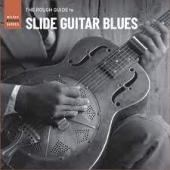
Various Artists
Rough Guide To Slide Guitar Blues
Label: World Music Network
Genre: 60s / 70s Rock / Pop / Progressive / Kraut
Availability
- LP €15.99 In Stock
Musicians from all around the world have long learnt to harness the otherworldly sound created when sliding an object across the strings of an instrument. For well over a hundred years, blues guitarists have adopted this approach by using bottlenecks, bones and all manner of metal objects to create exhilarating melodies and driving chords. The luminous tones of slide playing have duly become one of the most enduring special effects associated with the guitar whilst helping to convey the raw and emotional power of the blues.
The earliest roots of the blues belong in West Africa, where it’s thought the instrument commonly known as the ‘diddley bow’ derives. Typically consisting of a wooden board from a floor or shack with a single wire string stretched between two screws or poles, the diddley bow was played by plucking whilst varying the pitch with a metal or glass slide held in the other hand. Although considered a child’s instrument, its significance lies in the fact that it provided the first musical steps for future blues luminaries including Bukka White, Muddy Waters and Elmore James.
The mesmerizing sound created by a slide guitarist was famously first documented by the composer and self-confessed ‘Father of the Blues’ W.C. Handy. Whilst waiting for a train in Tutwiler, Mississippi in 1903, Handy was awakened by a haunting melody of a guitarist playing with a knife, which in his words created “the weirdest music I had ever heard.” This experience had a profound influence on the development of Handy’s compositional style as he helped popularise the blues.
Around the time of Handy’s encounter, Hawaiian steel guitar - a distinctive slide style that arose separately in the islands during the late 19th century - had already gained popularity on the U.S. mainland through the concert tours of Hawaiian musicians. Although Hawaiian guitar ultimately made its most significant mark on American country music, it’s likely that blues music, Hawaiian guitar and country music were to some degree mutually influential in the course of their early development. Certainly, traces of the Hawaiian style can be heard in the playing of a few of the featured guitarists, notably Casey Bill Weldon, who fittingly became billed as the ‘Hawaiian Guitar Wizard’.
The use of the slide enabled the creation of supple melodies and runs at heightened speed like Kokomo Arnold’s ‘Feels So Good’, whilst also allowing guitarists to play slowly and take advantage of its ability to sustain notes, beautifully illustrated by Tampa Red’s closing track ‘Moanin’ Heart Blues’. Picking out a melody on the top strings with greater resonance lent itself perfectly to gospel tunes as well through the playing of guitar evangelists such as Blind Willie Johnson and Rev. Edward W. Clayborn. All these tracks prove how the player’s ear, and not eyes, was central to the art of playing slide, as pitch intonation depends on touching the string in exactly the right place. In essence, the slide guitarist must play more like a violinist, always acutely conscious of pitch.
The Mississippi Delta blues has long been synonymous with the use of the bottleneck through the likes of Charley Patton, Bukka White and Son House. However, equally distinctive was the slide guitar artistry of bluesmen who performed in and around the Texas region such as Black Ace, Oscar Woods and Ramblin’ Thomas, whose playing represented a more refined and melodically complicated approach. Likewise, several notable East Coast bluesmen including Blind Willie McTell, Curley Weaver and Barbecue Bob had their own characteristic styles and are good examples of how easily distinguished the touch and timing of a particular player is when using a slide.
